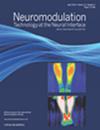Neurostimulation for the Treatment of Cancer-Induced Pain: A Scoping Review
IF 3.2
3区 医学
Q2 CLINICAL NEUROLOGY
引用次数: 0
Abstract
Objectives
Cancer pain is among the most prevalent and challenging symptoms in cancer care, with up to 95% of patients with late-stage cancer experiencing moderate-to-severe pain. Conventional pharmacologic treatments, including opioids, carry risks, and patients’ conditions may be refractory to medical management or have contraindications. Neurostimulation techniques, such as spinal cord stimulation (SCS), dorsal root ganglion stimulation (DRGS), and peripheral nerve stimulation (PNS), have shown promise in treating treatment-induced cancer pain. However, a comprehensive review focusing on these techniques for cancer-induced pain alone is necessary.
Materials and Methods
A comprehensive literature review was conducted using Medline, Embase, and Cochrane Library data bases, focusing on studies from 2000 onward. Inclusion criteria included interventional and observational studies reporting on SCS, DRGS, and PNS in cancer-induced pain. Studies addressing treatment-induced pain, systematic reviews, meta-analyses, and non-English studies were excluded. Data were extracted and evaluated using the Grades of Recommendation, Assessment, Development, and Evaluation system.
Results
The search yielded 831 references, with 24 studies meeting the inclusion criteria. Sixteen studies focused on SCS, seven on PNS, and two cases on DRGS. SCS showed significant pain reduction, with an average decrease in numeric rating scale (NRS) scores from 8.0 to 2.2 over an average 8.4-month follow-up period. PNS also indicated substantial pain relief, with NRS scores decreasing from 8.29 to 3.04 over an average 5.2-month follow-up period. DRGS, although less studied, showed a reduction in NRS scores from 6.0 to 1.0 over an average 6.0-month follow-up period. SCS was associated with a significant reduction in opioid use, with average reported morphine equivalent daily dose (MEDD) change from 1152.2 mg to 739.7 mg over an average 5.0-month period, whereas PNS and DRGS had limited impact on opioid consumption, with no reported MEDD change.
Conclusions
Our scoping review synthesizes evidence on neurostimulation interventions for treating cancer-induced pain. Current evidence suggests that interventions such as SCS, DRGS, and PNS may provide clinically meaningful pain relief in patients with cancer-induced pain. Several studies also reported improvements in functionality and quality of life. However, the level of evidence is limited owing to the lack of prospective comparative studies, clinical and methodologic heterogeneity, and small sample sizes.
神经刺激治疗癌症引起的疼痛:范围综述。
目的:癌痛是癌症治疗中最普遍、最具挑战性的症状之一,高达 95% 的晚期癌症患者会出现中度至重度疼痛。包括阿片类药物在内的传统药物治疗存在风险,而且患者的病情可能对药物治疗无效或有禁忌症。神经刺激技术,如脊髓刺激(SCS)、背根神经节刺激(DRGS)和周围神经刺激(PNS),在治疗诱发的癌痛方面已显示出前景。然而,有必要单独对这些治疗癌症诱发疼痛的技术进行全面综述:我们使用 Medline、Embase 和 Cochrane 图书馆数据库对 2000 年以来的研究进行了全面的文献综述。纳入标准包括报告 SCS、DRGS 和 PNS 治疗癌症诱发疼痛的介入性和观察性研究。排除了针对治疗诱发疼痛的研究、系统综述、荟萃分析和非英语研究。采用推荐、评估、发展和评价系统对数据进行提取和评价:检索结果显示,共有 831 篇参考文献,其中 24 项研究符合纳入标准。其中 16 项研究关注 SCS,7 项研究关注 PNS,2 项研究关注 DRGS。SCS显示疼痛明显减轻,在平均8.4个月的随访期内,数字评分量表(NRS)平均评分从8.0分降至2.2分。PNS 也显示疼痛大幅缓解,在平均 5.2 个月的随访期内,NRS 分数从 8.29 分降至 3.04 分。DRGS 虽然研究较少,但在平均 6.0 个月的随访期内,NRS 评分从 6.0 分降至 1.0 分。SCS 与阿片类药物使用量的显著减少有关,在平均 5.0 个月的随访期间,报告的吗啡当量日剂量(MEDD)从 1152.2 毫克降至 739.7 毫克,而 PNS 和 DRGS 对阿片类药物消耗量的影响有限,没有报告 MEDD 发生变化:我们的范围综述综合了有关治疗癌症引起的疼痛的神经刺激干预措施的证据。目前的证据表明,SCS、DRGS 和 PNS 等干预措施可为癌症诱发疼痛患者提供有临床意义的疼痛缓解。有几项研究还报告了功能和生活质量的改善情况。然而,由于缺乏前瞻性比较研究、临床和方法异质性以及样本量较小,因此证据水平有限。
本文章由计算机程序翻译,如有差异,请以英文原文为准。
求助全文
约1分钟内获得全文
求助全文
来源期刊

Neuromodulation
医学-临床神经学
CiteScore
6.40
自引率
3.60%
发文量
978
审稿时长
54 days
期刊介绍:
Neuromodulation: Technology at the Neural Interface is the preeminent journal in the area of neuromodulation, providing our readership with the state of the art clinical, translational, and basic science research in the field. For clinicians, engineers, scientists and members of the biotechnology industry alike, Neuromodulation provides timely and rigorously peer-reviewed articles on the technology, science, and clinical application of devices that interface with the nervous system to treat disease and improve function.
 求助内容:
求助内容: 应助结果提醒方式:
应助结果提醒方式:


